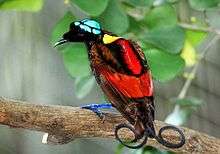Wilson's bird-of-paradise
| Wilson's bird-of-paradise | |
|---|---|
 | |
| Male | |
| Scientific classification | |
| Kingdom: | Animalia |
| Phylum: | Chordata |
| Class: | Aves |
| Order: | Passeriformes |
| Family: | Paradisaeidae |
| Genus: | Cicinnurus |
| Species: | C. respublica |
| Binomial name | |
| Cicinnurus respublica Bonaparte, 1850 | |
| Synonyms | |
|
Diphyllodes respublica | |
The Wilson's bird-of-paradise (Cicinnurus respublica) is a species of passerine bird of the family Paradisaeidae.
An Indonesian endemic, the Wilson's bird-of-paradise is distributed to the hill and lowland rainforests of Waigeo and Batanta Islands off West Papua. Its diet consists mainly of fruits and small insects.
Due to ongoing habitat loss, limited range and exploitation, the Wilson's bird-of-paradise is evaluated as Near Threatened on the IUCN Red List of Threatened Species. It is listed on Appendix II of the Convention on International Trade in Endangered Species of Wild Fauna and Flora (CITES).
The first footage of the Wilson's bird-of-paradise ever to be filmed was recorded in 1996 by David Attenborough for the BBC documentary Attenborough in Paradise. He did so by dropping leaves on the forest floor, which irritated the bird into clearing them away.
Nomenclature
The controversial scientific name of this species was given by Charles Lucien Bonaparte, Napoleon's nephew and a republican idealist, who described the bird from a badly damaged trade specimen purchased by British ornithologist Edward Wilson. In doing so, he beat John Cassin, who wanted to name the bird in honour of Wilson, by several months. Thirteen years later, in 1863, the German zoologist Heinrich Agathon Bernstein discovered the home grounds of the Wilson's bird-of-paradise in Waigeo Island.
Description
Wilson's bird-of-paradise is small, up to 21 cm (8.3 in) long. The male is a red and black bird-of-paradise, with a yellow mantle on its neck, light green mouth, rich blue feet and two curved violet tail feathers. The head is naked blue, with a black double cross pattern on it. The female is a brownish bird with bare blue crown.
In the field, the blue bare skin on the crown of the bird's head is so vivid that it is clearly visible by night; the deep scarlet back and velvet green breast are lush, the curlicue tail gleaming bright silver.
References
- ↑ BirdLife International (2012). "Cicinnurus respublica". IUCN Red List of Threatened Species. Version 2013.2. International Union for Conservation of Nature. Retrieved 26 November 2013.
External links
| Wikimedia Commons has media related to Cicinnurus respublica. |
| Wikispecies has information related to: Cicinnurus respublica |
- BirdLife species factsheet for Cicinnurus respublica
- BBC Video Segment - Wilson's Bird of Paradise
- Wilson's Bird of Paradise Image at PBase
- Cicinnurus respublica on Avibase
- Wilson's bird-of-paradise videos, photos, and sounds at the Internet Bird Collection
- Wilson's Bird of Paradise photo gallery at VIREO (Drexel University)
- Interactive range map of Cicinnurus respublica at IUCN Red List maps
- Audio recordings of Wilson's bird-of-paradise on Xeno-canto.
